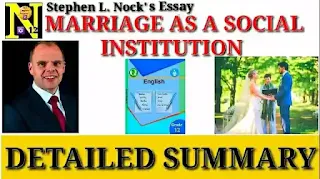 |
| Neb English Support Class 12 |
Section 2: Literature (Essays)
Marriage as a Social Institution Summary | Stephen L. Nock
Marriage as a Social Institution by Stephen L. Nock
MAIN INTRODUCTION
ABOUT THE AUTHOR
Stephen L. Nock
Write about the author of the essay "Marriage as a Social Institution".
Steven L. Nock (March 11, 1950 - January 26, 2008) was a researcher, author, and Commonwealth Professor of Sociology at the University of Virginia. He wrote extensively on the role of marriage in society and worked for the Federal Department of Health and Human Services as a consultant on American family policy. He authored textbooks and articles about the causes and consequences of change in the American family. He investigated issues of privacy, unmarried fatherhood, cohabitation, commitment, divorce and marriage. His book, Marriage in Men's Lives, won the William J. Good Book Award from the American Sociological Association for the most outstanding contribution to family scholarship in 1999.
MAIN SUMMARY
Marriage as a Social Institution by Stephen L. Nock
Write a summary of the essay "Marriage as a Social Institution" by Stephen L. Nock.
The essay "Marriage as a Social Institution" was written by Steven L. Nock. In this essay, the author has examined the national marriage debate by reviewing the social and demographic trends that have changed the role of marriage and the family. According to him, marriage and parenthood are private matters, relevant only to the individuals directly involved. He has pointed out the programmes that have strengthened marital relationships, lowered divorce rates, reduced out-of-wedlock births and encouraged responsible fatherhood.
A marriage is much more than the sum of two spouses. It is also a relationship defined by legal, moral, and traditional beliefs and has a variety of close personal ties and associations. Spouses are legally, morally and socially united by various personal and social relations.
Couples react to each other, culture, society and the rules and values that define them as a unit since they are life partners. Married males, in particular, had greater physical and mental health than married women.
Marriage, as a social institution, is carefully examined as a major social structure that affects men. In this essay, the author claims that the position of the spouse is of special importance in the lives of men. The institution of traditional marriage helps men develop their masculinity as they age. In a marriage, a homosexual grows up, maintains, and shows his masculine identity. After marriage, husbands are made the head of the household. Fidelity (loyalty to one's spouse or partner) and upbringing are the hallmarks of a normal marriage.
The essayist cites French sociologist Emile Durkheim to support his view. Emile believes that marriage benefits men because it is a part of society. Due to this relationship, two people get a chance to enjoy a harmonious and happy life. Marriage improves the civic qualities of men and helps them find the purpose of their lives. Married people are less likely to commit suicide than unmarried people. Marriage is an effective way of curbing one's irrational desires and wants. To the desire of love, marriage binds a man to only one woman throughout his life, which provides moral balance to his life. Men must get married, as it gives them direction in life and helps them achieve their goals.
CLICK HERE 👇 TO READ
ALL ESSAYS IMPORTANT QUESTIONS' SOLUTION PACK
Nowadays, unmarried cohabitation (living together) is not generally and legally recognised because they do not follow common beliefs, have limitations in conduct, and have no responsibility towards each other. There is no identity and no institutional linkage. Cohabitation without marriage is living together without marriage. They do not boldly identify themselves as husband and wife. A married couple conforms to patterns, traditions, and rules as husband and wife and enjoys acceptance from all. There are laws, religions, and customs protecting their relationship.
Americans generally agree about the six dimensions of marriage. Together, these form a standard definition of marriage. These six dimensions of marriage are as follows:
1. Marriage based on love is a free personal choice.
2. Maturity is a presumptive requirement for marriage.
3. Marriage is a heterosexual relationship.
4. In a marriage, the husband is the head and the main earner.
5. Sexual fidelity (loyalty) and monogamy are the requirements for marriage.
6. Marriage usually involves children.
Marriage establishes a relationship based on credibility and trust. Social capital has advantages for individuals who have it. The couple meets new blood relatives. The institution of marriage is personal property but is more difficult to maintain because it exists only through relationships with others. We have an obligation to help and support each other when we need it. The foundation of the new partnership is built on mutual trust and belief.
Post a Comment